There are so many different effects pedals out there for electric guitars, that it can really hard to decide which ones to go for. You might be wondering which effects should you start with? Or what pedals will be the best value for money?
In this post I’ll go through the essential pedals for rock music to help you achieve the best tone, plus some more pedals you may want to look into for lead guitar and other effects. So let’s get started!
Best Pedals for Rock Music
The best pedals for rock music are distortion, overdrive, compression and reverb. These will make the biggest difference in adding high quality saturation and sustain. Other useful pedals for rock include boost pedals for soloing, EQ pedals and delay effects.
Here’s a list of the most essential pedals for rock, I’ll go through them individually explaining why they’re important, how you should use them and the best in each category.
Essential Pedals for Rock Music
- Distortion
- Overdrive
- Compression
- Reverb
Distortion
Distortion pedals are probably one of, if not the most well known pedal types out there, and you’ll find a distortion pedal in pretty much every rock guitarists collection, particularly those who play heavier genres. They’ll add that classic heavy gain that gives you tonnes of sustain.
why is it important?
Distortion pedals are important because they will give you a huge boost of gain and sustain, which is great for both rhythm and lead guitar sections of heavy rock music. Of course, most amplifiers allow you to crank up the distortion, but you have more control over it if you use a separate pedal instead.
how should you use it?
How you should use a distortion pedal depends on the type of song you’re playing. A lot of rock songs switch from clean to distorted tones, so having a distortion pedal turned on for parts of a song can be really helpful. Distortion pedals can also be used to give you a boost in volume, as well as gain, which is helpful for soloing. Alternatively, you can have your distortion pedal always on, and dial in the exact amount of gain that you need.
what is the best distortion pedal?
If you’re after a lot of versatility, and want to have a overdrive and distortion capabilities using a single pedal, then you should take a look at the Boss OS-2 Distortion/Overdrive Pedal. It’s what I currently use because it stops my pedal board getting cluttered, and it’s really versatile and gives you tonnes of high quality gain on tap.
If you’re just after pure distortion, then you may want to look at something a bit heavier like the Boss DS-1 Distortion Pedal.
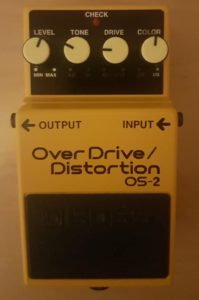
Overdrive
Overdrive pedals are often confused with distortion pedals, but they do actually sound pretty different. Overdrive pedals imitate the sound you would get if you cranked a valve (tube) amp up until the tone started to crackle up. They’re similar to distortion pedals in that they give you added gain, but they are a bit less aggressive and sound crunchier.
why is it important?
If you’re looking for a classic rock ‘n’ roll tone, then the chances are you need an overdrive pedal to achieve it. Pretty much every rock guitarist owns an overdrive pedal because the tone is so unique and sounds great.
how should you use it?
Similar to with distortion pedals, you can either use them to give you a boost for solos, or you can have them turned on all the time. Most overdrive pedals have a drive control (refers to the amount of gain), a level control (similar to volume) and tone knob (allows you to control the bass and treble frequencies). Check out this post on the uses of overdrive pedals to find out more about how to get the most out of them.
what is the best overdrive pedal?
The Ibanez Tube Screamer is one of the most iconic overdrive pedals of all time, and it’s used by loads of professional guitarists.
The Ibanez Tube Screamer Pedal comes in a few main forms:
- Ibanez TS9 Tube Screamer Overdrive Pedal
- Ibanez TS808 Tube Screamer
- Ibanez TS9DX Tube Screamer
- Ibanez Tube Screamer Mini Overdrive pedal
Take a look at this post on the Ibanez Tube Screamer to find out more about the differences between these models.
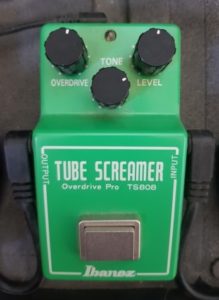
Compression
Another super important pedal for rock guitarists, is a compressor. They’re not as glorified as distortion and overdrive pedals, but if you’ve ever tried one, you’ll understand how good they are. Overdrive pedals have the ability to smooth out the sound of your guitar. They do this by decreasing the volume when you pluck a string to aggressively, so you don’t get unwanted spikes in the volume.
why is it important?
Compression pedals are important for two reasons.
- The allow you to create a smoother tone.
- The increase the sustain of your tone.
Both of these things are super helpful if you’re a rock guitarist. They’ll really help improve the overall tone of your guitar and make it sound more polished and professional.
how should you use it?
Compression pedals can either be used as an effect, or left on all the time. It really depends on what you want your compressor to do. If you need it to just improve your overall tone, then keep it switched on. Otherwise, you can use it for added sustain when playing solos, or for consistent volumes when finger picking. Take a look at my post on compression pedals to find more out on how they work and how to use them.
what is the best compression pedal?
The Keeley Compressor pedal is the best one I have tried. It sounds very professional, and gives you loads of control over your sound as you can adjust the sustain, level, blend and tone. If you don’t want to spend as much though, then check out the Boss CS-3. You’ll still get all the main controls in a robust and durable design.
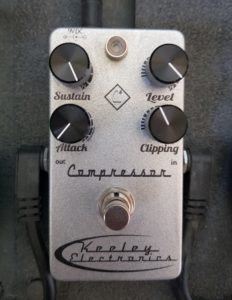
Reverb
The last pedal on this list of essentials for rock music, is the reverb pedal. If your amp doesn’t come with a reverb control, then you should definitely consider investing in a pedal. And even if it does, being able to control your reverb independently and turn it on and off during playing is really useful.
Reverb pedals are a difficult effect to describe. They sound almost as if you’re playing in a huge empty room, giving you a kind of echo effect that gives you loads of depth to your tone.
why is it important?
If you feel like there’s just something lacking with your rock tone, but you really can’t put your finger on what it is, then my best guess is that it doesn’t have reverb. Most professional guitarists have reverb on pretty much all the time, because it gives you a lot more depth and presence.
how should you use it?
Most guitarists tend to have reverb on all the time, but just at low levels. This way it’ll give you plenty of depth to your tone, but without sounding really fake. Alternatively, you can choose to use it just when soloing to give you that added boost.
what is the best reverb pedal?
The Boss RV reverb pedal is a great option to go for if you want this kind of effect. It’s versatile and easy to use most importantly. But it’s also a really well-made pedal in terms of the build quality. It’s sturdy and solid, so you’ll have no problems if you want to take it gigging with you.
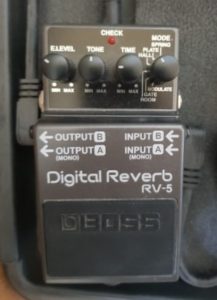
Pedals for Lead Guitarists
So now we’ve been through the most essential pedal effects for rock music, I thought it’d be a good idea to mention some that are really useful specifically for lead guitarists.
best pedals for rock lead guitarists
- Boost pedals
- Delay pedals
- EQ pedals
Boost
If you’re looking to kick your solos up a notch, then you should really consider investing in a good quality boost pedals. Their main function is to increase the volume so you can be heard in certain sections of a song. You can also adjust the gain, and EQ, depending on which pedal you go for.
why is it important?
Using a boost pedal is the easiest way to make your solos heard, but without impacting other aspects of your tone like the treble, bass and mids frequencies and the amount of gain.
how should you use it?
As the name suggests, you should only really use a boost pedal when you need that added boost during a song. This is usually for solos, or other lead sections. You can adjust the level to allow you to control the volume, and the gain and tone controls to make more specific changes to your tone.
what is the best boost pedal?
The XOTIC AC Booster Pedal is a great option if you are a lead guitarist. You get plenty of control over your tone with specific knobs for gain, treble and bass, as well as volume of course. This makes it a great option for both clean and dirty boosting.
Delay
Delay pedals are similar to reverb pedals, in that they are a time-related pedal effect. Their function is to take a chord or note and repeatedly play it back to you at the frequency, duration and volume you specific.
why is it important?
Delay pedals are very commonly found on a lead guitarist’s pedal board. They aren’t necessarily an essential effect, but for a lot of solos, they can give you more depth and presence, similar to a reverb pedal.
how should you use it?
Delay pedals should only really be switched on at certain times, and shouldn’t be left on constantly. You’ll want to use a delay pedal for single notes as opposed to chords, or it can start to sound a bit messy.
what is the best delay pedal?
The Boss DD-7 Digital Delay Pedal is a solid option in this category. Like with all Boss pedals, they’re built to last and they look great on every pedal board. You’ll get a high quality delay function and plenty control over the parameters like the volume, number of repeats etc.
Equaliser
If you want to really dial in the perfect rock lead guitar tone, then take a look at EQ (equaliser) pedals. This allows you to control the frequencies that are emphasised in your tone, like the bass, mids and treble. Having more control over the frequency will give you the ability to really get the perfect tone.
why is it important?
EQ pedals give you loads of added versatility. Controlling the bass, mids and treble frequencies allows you to either cut through more with your tone, or give it more depth and warmth. It’s really helpful if you feel like you need to change the EQ midway through a song, or your amps controls just aren’t cutting it.
how should you use it?
You can either have an equaliser pedal on all the time, or just turn it on as an added effect. The best thing about EQ pedals is the added versatility you get by using them. There really aren’t any rules with how you use them!
what is the best EQ pedal?
The Boss GE-7 is a great EQ pedal option. It may look at little bit complicated at first, but if you spend the time to get to know it, it’ll be your best friend. You get 7 bands of EQ which gives you a boost of 15dB in whichever band you choose.
Guitar Center have a huge range of effects pedals at great prices so make sure you check them out if you’re in the market for one. Here’s a link to take you directly to Guitar Center’s effects pedal range so you can check for current deals.
More Useful Pedals for Rock
So if you really want to go all out with your pedal board, then you can also look into getting some other effects. Here are some more of the most popular pedal effects amongst rock guitarists.
Wah Pedals
Wah-pedals are very popular with rock guitarists in a range of different styles from metal to blues-type rock ‘n’ roll. They’ve famously been used by Hendrix, Zakk Wylde, Joe Satrini, Tom Morello, Bob Marley and Stevie Ray Vaughan. The Vox V845 Wah is a great option that doesn’t cost a tonne either!
Acoustic Simulator Pedals
A lot of rock bands switch between acoustic and electric guitars in the verse and chorus, respectively. So how do they do it live without swapping guitars midway through the song? Well, a lot of guitarists use an acoustic simulator pedal to make this transition seamlessly, without switching instruments. The Boss AC-3 Acoustic Simulator pedal is highly regarded as one of the best options out there if you want to turn your electric guitar’s sound into an acoustic tone
Modulation Effects Pedals
Modulation is an umbrella term for a number of different effects. These include:
- Tremolo: mimics a tremolo arm, so gives you allows you to change the pitch of the strings you’re playing e.g Boss TR-2
- Phaser: this adds a kind of whooshing sound e.g TC Electronic Helix
- Chorus: this sounds like multiple guitars are being played at once e.g. TC Electronic Corona
Tuner Pedals
Tuner pedals may not seem that useful, unless you own multiple guitars. If you use one pedal board and a few different guitars, then using a tuner pedal is a really quick way to check the tuning is correct without having to mess about with headstock tuners. That’s why most professional guitarists have a tuner pedal on their board to be safe when playing on stage. If you’re after a good tuner pedal, then take a look at the TC Electronic PolyTune 3.
Organising your new pedalboard? Check out my ultimate guide to designing a pedalboard including all the equipment you need and a step by step formula to getting set up in a pain-free way.
More Frequently Asked Questions
Now we’ve been through all the best effects pedals for rock music, here are the answers to some other questions you may still have.
do I need effects pedals?
So it’s true, not every electric guitarists needs effects pedals. However, they do have several advantages.
- They can be turned on and off easily throughout a song allowing you to have multiple tones within the same song.
- Pedals are easy to operate and setup.
- They give you a range of effects that most amps can’t.
Whether or not you need effects pedals depends on several things including the type of songs you’re playing, your amplifier and guitar, and the tone you’re after. Take a look at this post to help you decide if you should invest in effects pedals.
how do i connect pedals to my guitar and amplifier?
This is a pretty simple process. To connect your pedals to your amp and guitar, you just need an extra cable (like the one you use to connect your amp and guitar directly. The pedal has an input (for your guitar cable) and an output (for your amp cable). Once you connect all of them together in this chain, you’ll be able to use your pedal! Take a look at this post on how to set up your effects pedals for some more detail.
what is the best pedal chain order?
Looking to get the best out of your pedals? Check out my article on the best pedal chain order here to learn everything you need to know about setting up your chain.
what is a pedal board?
Pedal boards are great if you own multiple pedals and want to be able to organise and transport them easily. Some pedal boards just act as a place to keep everything neat, but others include a power supply as well. Here’s a quick picture of my pedal board.
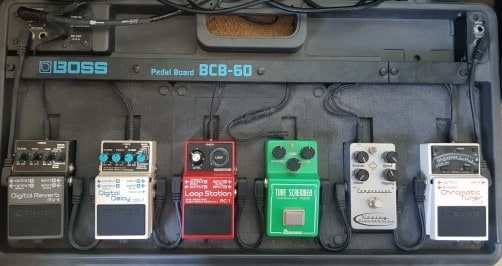
Something like the Boss BCB-60 is a great option if you want to invest in a pedal board. It’s lightweight and very well designed with a padded interior. It comes with an AC adaptor so it can be connected to a power supply and has enough room for 6 pedals to sit comfortably. It also has a lid and handle making it really great for transporting. You can check out the Boss BCB-60 on Amazon.
So there you go! That’s the ultimate guide to guitar effects pedals for rock music! I hope you’ve found this article helpful, thanks for reading. Here are some other posts you might find useful:
